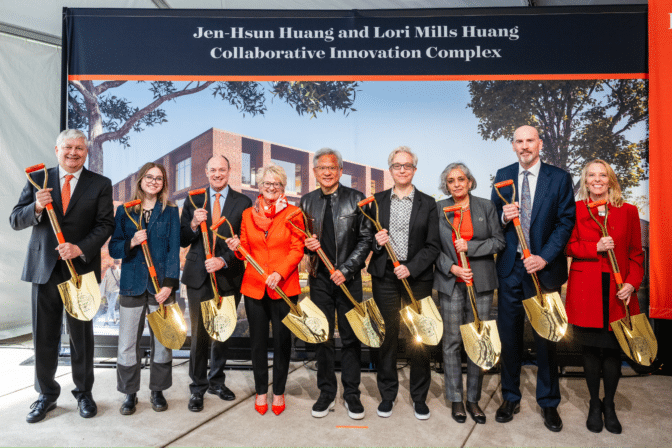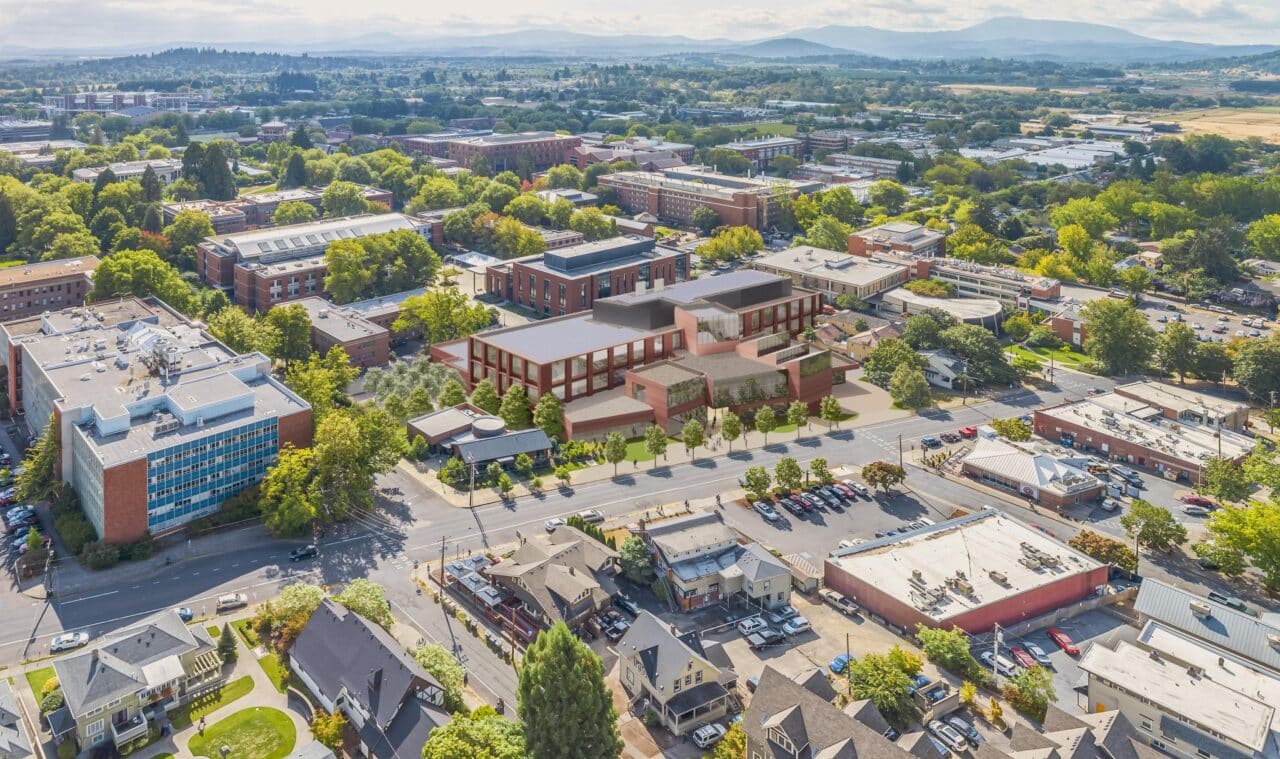AI promises to bring the full benefits of the digital revolution to billions across the globe, NVIDIA CEO Jensen Huang said Friday during a conversation with Oregon State University President Jayathi Murthy.
“I believe that artificial intelligence is the technology industry’s single greatest contribution to social elevation, to lift all of the people that have historically been left behind,” Huang told more than 2,000 faculty, students and staff gathered for his conversation with Murthy.
The talk was the highlight of a forum marking the groundbreaking for a new research building that will be named for Huang and his wife, Lori, both Oregon State alumni.
The facility positions Oregon State as a leader not just in the semiconductor industry but also at the intersection of high performance computing and a growing number of fields.

Those innovations have world-changing implications.
Huang said those who know a programming language such as C++ typically have greater opportunities.
“Because programming is so hard, the number of people who have benefitted from this, putting it to use for their economic prosperity, has been limited,” Huang said.
AI unlocks that and more.
“So you essentially have a collaborator with you at all times, essentially have a tutor at all times, and so I think the ability for AI to elevate all of the people left behind is quite extraordinary,” he added.
Huang’s appearance in Corvallis, Oregon, capped off a week of announcements underscoring NVIDIA’s commitment to preparing the future workforce with advanced AI, data science and high performance computing training.
On Tuesday, NVIDIA announced that it would participate in a $110 million partnership between Japan and the United States, which would include funding for university research.
On Wednesday, Georgia Tech announced a new NVIDIA-powered supercomputer that will help prepare undergraduate students to solve complex challenges with AI and HPC.
And later this month, NVIDIA founder Chris Malachowsky will be inducted into the Hall of Fame for the University of Florida’s Department of Electrical & Computer Engineering, following the November inauguration of the university’s $150 million Malachowsky Hall for Data Science & Information Technology.
Educating Future Leaders for ‘New Industrial Revolution’
NVIDIA has been investing in universities for decades, providing computing resources, advanced training curricula, donations and other support.
These contributions enable students and professors to access the high performance computing necessary for groundbreaking results at a key moment in the history of the industry.
“We’re at the beginning of a new industrial revolution, and the reason why I say that is because an industrial revolution produces something new that was impossible to produce in the past,” Huang said.
“And in this new world, you can apply electricity, and what’s going to come out of it is a whole bunch of floating-point numbers. We call them tokens, and those tokens are essentially artificial intelligence,” Huang said.
“And so this industrial revolution is going to be manufacturing intelligence at a very large scale,” Huang said.
OSU Breaks Ground on $213 Million Research Complex
Friday’s event in Oregon highlighted the Huangs’ commitment to education and reflected the couple’s deep personal ties to Oregon State, where the two met.
The conversation with Murthy followed the groundbreaking for the Jen-Hsun Huang and Lori Mills Huang Collaborative Innovation Complex, which took place Friday morning on the Corvallis campus.
When it opens in 2026, the 150,000-square-foot, $213 million complex — supported by a $50 million gift from the Huangs — will increase Oregon State’s support for the semiconductor and technology industry in Oregon and beyond.
Harnessing one of the nation’s most powerful NVIDIA supercomputers, the complex will bring together faculty and students to solve critical challenges facing the world in areas such as climate science, clean energy and water resources.
Huang sees the center — and AI — as helping put the benefits of computing at the service of people doing work across a broad range of disciplines.
Oregon State is one of the world’s premier schools in forestry, Huang said, adding that “let’s just face it, it’s very unlikely that somebody who was in forestry, it’s not impossible, but C++ is probably not your thing,” Huang said.
Thanks to ChatGPT, you can “now use a computer to apply it to your field of science and apply this computing technology to revolutionize your work.”
That makes learning how to think — and how to collaborate — more important than ever, Huang said. It’s “no different than if I gave you a partner to collaborate with you to solve problems,” Huang said.
“You still need to know how to collaborate, how to prompt, how to frame a problem, how to refine the solution, how to iterate on it and how to change your mind.”
NVIDIA Joins $110 Million Partnership to Help Universities Teach AI Skills
The groundbreaking at Oregon State is just one of several announcements highlighting NVIDIA’s global commitment to advancing the global technology industry.
Last week, the Biden Administration announced a new $110 million AI partnership between Japan and the United States, including an initiative to fund research through collaboration between the University of Washington and the University of Tsukuba.
As part of this, NVIDIA is committing $25 million to a collaboration with Amazon to bring the latest technologies to the University of Washington, in Seattle, and the University of Tsukuba, northeast of Tokyo.
Georgia Tech Unveils New AI Makerspace in Collaboration With NVIDIA
And on Wednesday, Georgia Tech’s College of Engineering established an AI supercomputing hub dedicated to teaching students.
The AI Makerspace was launched in collaboration with NVIDIA. College leaders call it a “digital sandbox” for students to understand and use AI. Initially focusing on undergraduates, the AI Makerspace aims to democratize access to computing resources typically reserved for researchers or technology companies.
Students will access the cluster online as part of their coursework. The Makerspace will also better position students after graduation as they work with AI professionals and help shape future applications.
‘Beginning of a New World’
To be sure, AI has limits, Huang explained. “It’s no different than when you work with teammates or lab partners; you’re guiding each other along because you know each other’s weaknesses and strengths,” he said.
However, Huang said now is a fantastic time to get an education and prepare for a career.
“This is the beginning of a new world and this is the best of times to go to school — the whole world is changing, right? New technology and new capabilities, new instruments and new ways to learn,” Huang said.
Images courtesy of Oregon State University.
